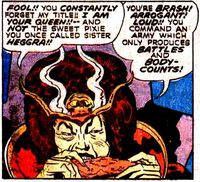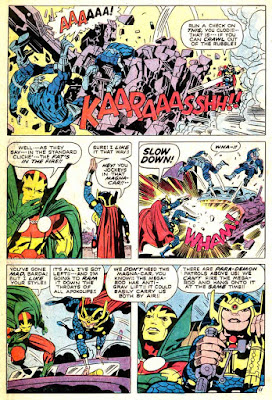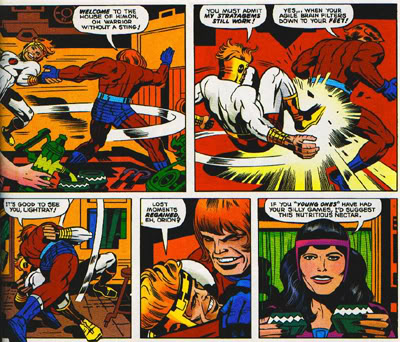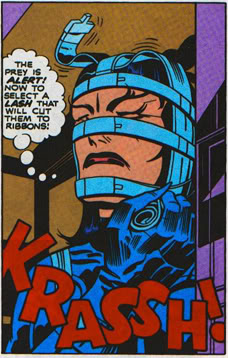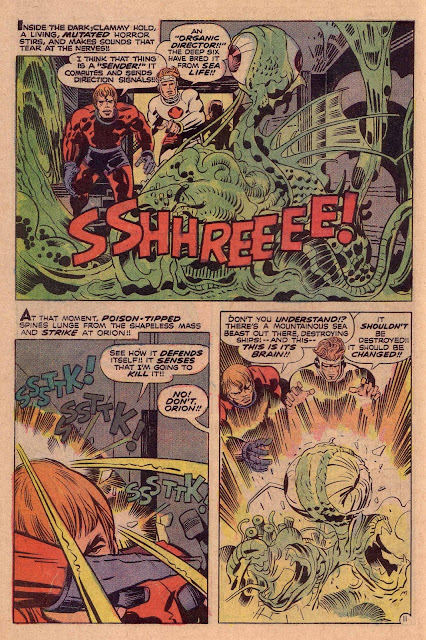I. Jack Kirby and the Fourth World
After leaving Marvel in 1970, Jack Kirby headed over to DC and threw himself into a feverish whirlwind of activity. A number of the titles he worked on - Superman's Pal, Jimmy Olsen, Mister Miracle, The New Gods and The Forever People - later became known as the 'Fourth World'. Kirby conceived of - and wrote and drew - a space-opera, a Wagnerian / sci-fi comic book epic. He introduced characters and concepts - such as Darkseid, the Source, Mark Moonrider - which later influenced George Lucas (Darth Vader, the Force, Luke Skywalker).
Unfortunately for Kirby - and his fans - most of the books were cancelled early in his tenure at DC, and Kirby returned to Marvel. The New Gods characters were revived in a new series in the late 1970s, and have showed up in DC comic books - and movies, TV shows and cartoons - ever since.
DC has reprinted the Fourth World series a number of times, most recently under the title Jack Kirby's Fourth World Omnibus. This four-volume set contains the revival of the New Gods in the 1980s under the title of Super Powers, a limited series which mimicked the Super Friends cartoon and comic book and which undid some of the 1970s continuity. We also find in here Kirby's Hunger Dogs (1985), a graphic novel which attempts to draw the saga to a close.
Most Kirby fans agree that his artistic skills peaked in the 1970s and atrophied somewhat (probably as a result of age and infirmity) by the 1980s. I myself like Super Powers and Hunger Dogs, but I'm forced to admit that Kirby's work there, especially the story-telling, lacked the fluidity and dynamism of old.
For this essay, I read through the four volumes and attempted to type each of the major characters (well, at least all the ones in the Who's Who of the DC Universe entry, see below) according to Myers-Briggs.
This wasn't that difficult, given that Taylor's blog Zombies Ruin Everything has typed just about every major Marvel and DC character (many of them co-created by Kirby). Reading through Taylor's personality profiles gave me the overall gist of each personality type - as it appears in popular culture - and so I could match each of Kirby's Fourth World characters to each 'stock type'.
I did run into a few obstacles. One of them was that many characters don't enjoy that much screen time, so to speak; we see them for a few pages and then they're gone. We only see Izaya's wife Avia for a few pages; likewise, Darkseid's ex-wife Tigra. How are we to type them? The answer is, by going off things such as visual cues. It's a point of contention in Myers-Briggs as to whether or not a person will 'look' their type; but in comic books, characters certainly look theirs.
Kirby invented a lot of characters, and a few superhero teams and ensembles and like most creators, he made it a practice not to include more than one of each Myers-Briggs type. Look at the Fantastic Four: Mister Fantastic, INTP; Invisible Woman, ENFJ; Human Torch, ESFP; the Thing, ESFJ. We'll find, as a general rule throughout comics, that types don't double up, so to speak, in superhero teams - one major exception being the current Guardians of the Galaxy. This means, then, that once we type five characters in a six man team, we can infer - by guesswork and a process of elimination - what the type of the six will be.
So without further ado, let's begin. I'll follow the practice of Calise Sellers and divide up the types into IPs (Introverted Perceivers), EPs (Extraverted Perceivers), IJs (Introverted Judgers) and EJs (Extraverted Judgers). For part I of this article, I'll focus on the EJs and IPs.
II. The EJs in the Fourth World
Let's start with the EJs - the Men of Action. To understand the EJ type a little better, we need to recap some of my earlier post.
It helps to think of the four functions in Myers-Briggs as belonging to a particular sphere. Each of the spheres gets wider and wider as it includes more things.
The most immediate sphere concerns yourself - what you see when you look in yourself at your own thoughts and feelings. One always undertakes introspection in that sphere: introverted thinking or feeling. The introverted thinker or feeler shuts out the external field and concentrates either on getting his thoughts in order or sorting through and evaluating his subjective (emotional) experiences. The EJ type tends to dislike this sort of activity; introspection - or what Calise Sellers calls Details and Data - makes up their repressed, inferior fourth function.
The next sphere represents a step outside one's head and into the real world, so to speak: the world of your actual friends, family, colleagues, business associates, neighbours. Here you look outward (and use the perceiving functions - sensing and intuiting) and develop a philosophy of life - what is or could be. Extraverted sensors appreciate visuals and the finer things in life, including the arts and fashion, but on the negative, can develop a philosophy of extraordinary cynicism, even pessimism (see the Rust Cohle character in the TV series True Detective). Extraverted intuitives enjoy exploring possibilities and visualising what could take the place of what is - they like dreams, ideals, fantasies and inventions; but they can often be too impractical, disorganised, spontaneous, and as a result, never get the chance to put their intuitions into a meaningful context (this is especially true of the ENFP and ENTP types). Or perhaps they babble on endlessly about all the connections and patterns they see out there in reality - think of Benedict Cumberbatch as Sherlock Holmes, an INTP, in the TV show Sherlock.
Both of these descriptions apply to the types who have extraverted sensing or intuiting as a primary or secondary function; they don't apply to the EJ, who has it as a tertiary function.
The EJ doesn't eschew extraverted intuition or sensing entirely: the ENFJ type (who may be a cult leader, see below) may enjoy finery; an ESTJ type, such as Captain America, may hold to ideals of freedom, patriotism, honour. Generally, though, the EJ doesn't make this sphere - the immediate personal, or what Sellers calls Observations and Motivations - a top priority; he doesn't care much about actual, real life human beings and what their hopes, visions, aspirations, foibles and quirks are. (Ask the typical EJ, 'Want to know how the world really works?' and he'll answer, 'No'). It's for this reason that the EJ, especially in a leadership role, can strike others as being ruthless.
The second sphere concerns an organisation - a corporation, a political group, a superhero team, an army, even a state. Action, planning, decisions and judgements count here the most. It's here that the EJ really shines: he jumps into action (and may appear to be impulsive) and makes the sphere of decisions and planning (or Action, as Sellers calls it) his top priority and he uses his primary function in that field. He will perform one of two roles: Master of Men (extraverted thinking), which means he's an executive or army officer type, or Communitarian (extraverted feeling), which means he's geared to what his particular organisation (whether it be a corporation, church group, political group, city, nation, planet) values and loves.
Finally we arrive at the broadest sphere of all - understanding the root principles and causes of all things, what may be called metaphysics. The EJ type uses his secondary function here. The primary and secondary functions appear to complement one another. A great statesman or military leader, whose default action role is that of an executive, may experience intuitions - introverted intuitions. He may know, in a psychic flash, what his enemy's next move will be; or he may trust in the fates and know - without being able to say why - that his audacious military gamble will succeed. Generally, this type believes in God, or Fate, or something larger than himself - something mystical that he can tap into at will. This holds true for the ENTJ and ENFJ type.
The other EJ types, the ESTJs and ESFJs, understand the universe and metaphysics through the body. They measure, using their bodies, weight, mass and volume and believe that things can be moved around with the application of the right amount of physical force. Being introverted sensors, too, they cling to accumulated sense impressions - impressions of the past. Jung, in his Psychological Types (1921) sounds quite mystical here. He posits that the sense impressions of one generation passes onto the next; accumulated sense impressions sit in the collective unconscious common all to human beings.
So let's look through the four EJ types. We'll start with the easiest of them all:
ENTJ: Executive / General; Shadow self: Tyrant.
Stock examples: Magneto (X-Men); Loki (Thor); Lex Luthor (Superman); Kingpin (Daredevil); Megatron (Transformers).
This type goes into Action first and plays the role of Master of Men, using extraverted thinking, Te; he also uses introverted intuition (Ni) to divine the Principles of the universe - the Principles being God / Fate.
Unquestionably, Darkseid belongs here. Perhaps he could be considered the poster boy for the ENTJ type.
Many other ENTJs appear in Kirby's Fourth World. Among them we can find Heggra, Darkseid's mother (a rival ENTJ who he poisons for the throne)...
And then we have Mantis the 'energy vampire', who has ambitions to rule Earth with the race of 'bug' people who live underground in New Genesis.
ESTJ: Mid-Ranking Officer / the Second in Command; shadow self: Draconian Drill-Sergeant.
STOCK EXAMPLES: Princess Leia (Star Wars); Captain America; Two-Face (Batman); Wonder Girl (New Teen Titans (1980s era)).
Like the ENTJ, the ESTJ goes into action with extraverted thinking Te, and is a Master of Men; unlike the ENTJ, the ESTJ uses introverted sensing - that is, one's bodily sensations and impressions - to deduce the Principles of the universe, which, by his reckoning, are Weight, Mass and Volume.
What this means is that the ESTJ will more often than not be an executive and a leader of some type, and because of the introverted sensing, will be focused either on physical fitness or on asceticism - pitting one's body (which contains one's subjective sense of self) against the world. The type also, because of the introverted sensing, are more likely to be biased towards the past (conservativism). They feel a sense of loyalty to their family and the organisation they belong to.
As a character, the ESTJ type is more likely to occupy the rank of Lieutenant or Captain than General. That is, they perform the role of second-in-command rather than first.
Big Barda, as leader of the Female Furies Battalion and member of the elite Special Powers Force, fits the role of the ESTJ type perfectly. In the comic book world, you are your job - and Barda's job is to be a drill sergeant.
ESFJ: The Mother Hen; shadow self: the Smotherer.
STOCK EXAMPLES: Superman; The Thing (Fantastic Four); Starfire (New Teen Titans); Cersei Lannister (Game of Thrones); Dr Leonard 'Bones' McCoy (Star Trek).
The ESFJ uses extraverted feeling, Fe, and is a Communitarian in his default action role; like the ESTJ, the ESFJ is an introverted sensor and understands the Principles of the universe as being Weight, Mass and Volume.
Orion's girlfriend (and Himon's daughter) Bekka, who first appears in Hunger Dogs, gives us a good example of the ESFJ type. Caring and maternal, the ESFJ in popular culture is usually a woman, or at least, very motherly.
I type Big Bear as an ESFJ because, out of all his team members, he seems to be the most Communitarian - the welfare of his fellow members (and civilian bystanders around him) counts the most to him. In addition, he resembles the Thing - another Kirby ESFJ character.
Granny Goodness stands out as one of the few bad guy ESFJs in comic books. She represents an ESFJ gone wrong. In a perverse way, she's a Communitarian, and what's more, her Orphanage is, it could be argued, an extension of her introverted sensing, Si. The Orphanage indoctrinates young men - and women - in Darkseid values and the values of Apokolips, and is conservative, even nostalgic. It places a great emphasis on physical culture - that is, physical training, not to mention disciplinary beatings - which again ties in with Si, but a bad Si.
ENFJ: Nurturing Leader / Hero Teacher; shadow self: Manipulative Guru / Cult Leader.
STOCK EXAMPLES: Dick Grayson / Nightwing (New Teen Titans); Wonder Woman;
Jean Grey (X-Men); Invisible Woman (Fantastic Four); Optimus Prime (Transformers); Obi-Wan Kenobi (Star Wars); Robin Williams in Dead Poets Society (1989); Hank Scorpio in The Simpsons.
Like the ESFJ, the ENFJ is a Communitarian; like the ENTJ, he understands the universe as God / Fate as perceived by introverted intuition, Ni.
Usually in popular culture this character will be a guru, evangelist, teacher or nurturing leader and thrives on being part of the group and before an audience. The ENFJ possesses a certain theatricality. But one can't confuse the ENFJ with the 'performer' type, the ESFP. The ENFJ, unlike the ESFP, doesn't work as a lone wolf; he seeks to weld a group together. His favourite word is synergy.
Mark Moonrider of the Forever People is described as a 'natural leader', and so he is. A natural leader like the ESTJ (Big Barda) or the ENTJ (Darkseid), you say? Not quite: he's too nice to be either one of those. It's for that reason that I put him in the ENFJ category. I'll admit that I cheated a little on this one: Mark Moonrider reminds me a little of Dick Grayson / Nightwing, another 'natural leader' and ENFJ who has led three or four super-teams.
The poster-boy for the 'ENFJ gone wrong' will always be, of course, Glorious Godfrey. A denizen of Apokolips, he travels to Earth and pretends to be an evangelist. He intoxicates his audiences with his mesmerising rhetoric and forms a militia called the Justifiers, who beat up people, destroy books and artefacts, and practice suicide bombing in the name of religion. What is the religion, you might ask? 'Anti-Life', which boils down to letting Darkseid doing your thinking for you and hailing Darkseid as a messiah.
III. The IPs in the Fourth World
It should be noted here that the IPs reverse-mirror the EJs. While the EJ disdains introspection (Details and Data) and doesn't have much time for human beings in the real world (Observations and Motivations), the IPs make Details and Observations their primary and secondary functions respectively. We see that their tertiary function is used in the sphere of the organisation and the unit (Action), which means that, while they can undertake decisions and planning, and do a good job, they don't accord them a high priority - for that reason, they can appear to others as lazy and not being highly motivated. In addition, they rarely seek out leadership roles. Reed Richards / Mister Fantastic stands as one of the few examples of the IP as leader of a superhero group; this exception proves the rule.
When the IP type does go into action, he takes up a default action role - either Zen Warrior or Master of the Body. The Zen Warrior uses introverted intuition. As a swordsman, he knows, by a gut feeling or hunch, when and where exactly to deliver the killing blow with his sword; as a pilot, he knows how to keep his spacecraft from colliding with that enemy spacecraft or asteroid. The Master of the Body, on the other hand, is just that: someone who practises physical self-discipline and knows how to use his body to defeat his foes (see Mister Fantastic, or a certain famous escape artist below).
ISTP: Taciturn Loner; shadow self: Cold Fish.
STOCK EXAMPLES: Wolverine (X-Men); Han Solo (Star Wars); Elektra (Daredevil); Black Widow (Avengers); Daredevil / Matt Murdock; James Bond; Deathstroke the Terminator (New Teen Titans); Darth Maul (Star Wars).
The ISTP sees himself as a Technician / Scientist (introverted thinking applied to Details and Data). In his philosophy of life, he is a Realist / Aesthetician (extraverted sensing applied to Observations and Motivations).
A staple in the movies and the comic books, the ISTP often appears as a 'lone wolf' mercenary, assassin or spy who makes up his own rules. The ISTP comic character will be graceful and fluid in their movements - efficiency in motion - and skilled at using a weapon, which almost appears as an extension of their body. Like his brother type, the ESTP, he dresses well.
Only two ISTPs appear in the Fourth World saga: Lashina of the Female Furies and Devilance the Pursuer. The former is a cold, quiet member of the Furies who uses whips and belts with great skill, the latter, a hunter for Darkseid who uses a lance.
Again, I cheated on this one. Lashina looks and behaves a lot like the Black Widow and Elektra, while Devilance reminds me of Darth Maul.
INFP: The Flower Child; shadow self: the Waif
STOCK EXAMPLES: Luke Skywalker (Star Wars); Nightcrawler (X-Men); Scarlet Witch (Avengers); David Duchovny in X-Files.
The INFP defines himself as a Poet / Romantic (introverted feeling, Details and Data) and holds to an Idealist / Inventor philosophy of life (extraverted intuition, Observations and Motivations).
The INFP could be best described as someone who consciously isolates himself from his surroundings and the people around him, who prefers to dwell in their subjectivity (that is, their thoughts and feelings). At the same time he is continually looking for and wanting to explore possibilities beyond the present. In other words, he's Luke Skywalker on Tatooine - someone who pays little attention to the present and invests almost nothing in it while keeping their eye on bright horizons. Typically, in popular culture, he just doesn't fit in; he will be an individualist who rejects the family or community or organisation he is born into and seeks something more. While the ESTJ can seem a natural fit for an organisation, the INFP can appear to be a natural un-fit.
Beautiful Dreamer's name evokes the INFP type the best, and Beautiful Dreamer should be classified as an INFP, being a gentle soul who can project illusions, images (some beautiful, others ugly and horrifying) of things that aren't there - her powers draw upon extraverted intuition, Ne.
(Again, I've cheated here: Beautiful Dreamer reminds me a lot of another Kirby creation, Scarlet Witch, an INFP).
Another candidate for INFP status is Forager. He lives in a colony of insect-like humanoids on New Genesis but rejects their ways. He dreams of reconciliation with the 'eternals' of New Genesis and freedom. His mentor, Prime-One - an Obi-Wan-type figure - is killed by the All-Widow, the queen of the colony, as part of a ritual, much to Forager's chagrin, and he escapes to Earth to warn Orion of a pending invasion by Darkseid's minion Mantis. Forager seems much more humanoid than his fellow 'bugs', and certainly he's very different - much more sensitive and questioning. We see parallels between him and Luke Skywalker.
Finally we come to the most prominent of all the INFPs in the Fourth World: Mister Miracle. We see a lot of similarity between him and Forager. The son of Izaya the Highfather, ruler of New Genesis, Scott Free is adopted by Darkseid as part of a peace treaty between Apokolips and New Genesis (INFP characters usually are adopted - Nightcrawler, Luke Skywalker, Scarlet Witch, Fox Mulder - or at least don't know who their real parents are) and grows up in Granny Goodness' Orphanage, which of course he loathes. Both Metron and Himon of New Genesis act as his mentors, and he learns - in secret - to build some technological wonder-devices, including a Mother Box. When attempting to escape, he is confronted by Darkseid and Himon. This scene evokes the ending of Empire Strikes Back (1980), in which Luke's father, Darth Vader, asks Luke to join him:
Scott, like Luke, doesn't go over to the dark side of the force.
He then jumps, like Luke, into a cylindrical chute.
INTP: Super-Scientist; shadow self: Egghead / Aspbergers-ish Super-Geek
STOCK EXAMPLES: Mister Fantastic (Fantastic Four), Doctor Manhattan (Watchmen), Man-Bat (Batman), Peter Parker / Spiderman, Victor Frankenstein, Sherlock Holmes, Sheldon from Big Bang Theory, Mr Freeze (Batman), the Lizard (Spiderman).
The INTP defines himself as a Technician / Super-Scientist, and his philosophy of life is Idealist / Inventor. In other words, he uses introverted thinking for Details / Data and extraverted intuition for Observations / Motivations.
We find a lot of INTPs in the comic books, and especially in Kirby's career - think of all the 'monster'-themed titles he worked on for Marvel and DC in the 1950s and early 1960s. 'Super-scientists' and 'Mad scientists who invent a creature which destroys the world' abound in these.
In the first issue of New Gods, Metron declares 'Who runs the universe matters not! What makes it run is my prime objective!'. He demonstrates some of the more amoral aspects of the INTP. Not interested in politics - only science - he gives away the secrets of Boom Tube teleportation to Darkseid in exchange for something called the 'X-Element' - an element he needs for the engine of his Moebius Chair (which is a vehicle which can traverse time and space). It could be argued that Metron is committing treason here. After the outbreak of war between Apokolips and New Genesis, he goes over to the good guys, but generally he doesn't participate in the action much.
Vykin the Black of the Forever People appears to be another INTP hero and a super-scientist type, who is always lugging around the Mother Box as though it's some piece of scientific equipment, e.g., a Geiger counter.
Two bad guy INTPs, Makkari and Simyan, run the Evil Factory, which is devoted to breeding creatures of destruction to wreak havoc on Earth. Makkari and Simyan resemble the Enclave in Fantastic Four - more Kirby super-scientists who have gone bad.
ISFP: Sensitive Bohemian; shadow self: Hippie Bum
STOCK EXAMPLES: Jeff Bridges in The Big Lebowski (1998); Legolas (Lord of the Rings); Jericho (New Teen Titans); Silk Spectre II (Watchmen); Poison Ivy (Batman).
The ISFP defines himself as a Poet / Romantic (Details and Data) and his philosophy of life consists of Realism / Aestheticism (Observations and Motivations).
As a character in popular culture, he more often than not doesn't pay much attention to politics and the outer world; he prefers to dwell on subjective and emotional experiences (introverted feeling). His realist philosophy of life (extraverted sensing) gives him a love of the plastic (that is, form-giving) arts, doing things with his hands and creating. While not an extraverted feeler, he can be empathic and he usually seeks peace and the putting of an end to all quarrels and conflicts. (Rest assured, however, if you start with him, he'll finish it). Usually ISFPs appear as graceful, almost elfin characters.
Lightray of New Genesis gives us the best example of the ISFP in Kirby's Fourth World. He serves as the cheerful and light counter-weight to the gloomy, brooding and destructive Orion.
He uses his powers to create beautiful things. In one instance, he remoulds an ugly creature of Apokolips into a New Genesis machine.
Another elfin character who likes creating beautiful things with his powers (or rather, his equipment - his 'cosmic cartridges') is Serifan.
Who can forget the cosmic cartridge which sends one young boy on a LSD-type trip:
Lastly, another gentle hippie type, who doesn't get much screen time, is Izaya's wife (and Mister Miracle's mother) Avia - another candidate for ISFP:
End of Part I. Mark Hootsen signing off.




